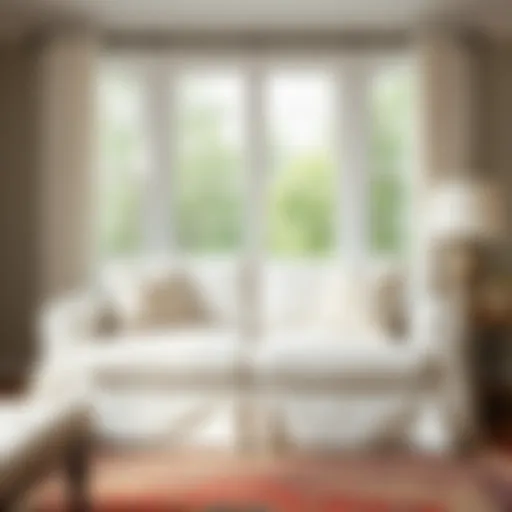Discovering the Benefits of Paper Window Coverings

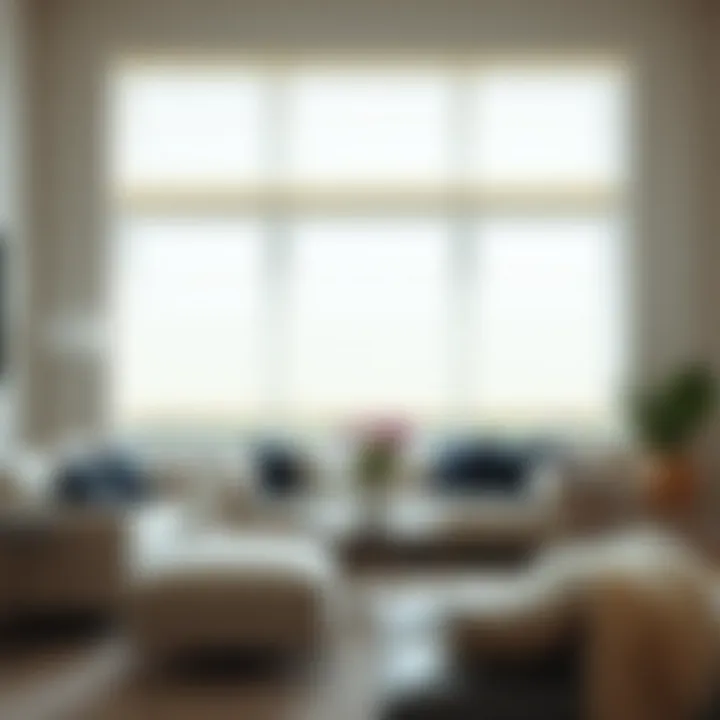
Intro
In a world where home design constantly evolves, the art of decorating extends beyond mere furnishings and finishes. Among these elements, window coverings stand as not just functional barriers between the outdoors and our indoor sanctuaries but also as impactful design statements. Remember the saying, "Your home is your castle?" It rings especially true when considering the small details, such as how light filters through a window, how privacy is maintained, and the overall ambiance it creates.
Paper window coverings have surged into the limelight, offering a blend of practicality, creativity, and sustainability. They provide a tailored solution that fits a variety of styles, from minimalist to bohemian, and often come with a significantly lower price tag compared to traditional materials.
As we dive deep into the realm of paper window treatments, we'll explore their many facets. From understanding the current trends in the market to delving into innovative DIY projects, the versatility and eco-friendliness of these coverings become very apparent. This isn't just about choosing a shade of color; it's about making informed choices that enhance your living space while also benefiting the planet. Let’s take a closer look at what makes paper window coverings more than just a passing trend.
Furniture Trends
Current Market Trends
Shifts in consumer preferences often dictate the popular choices in home decor. Recently, there has been a noticeable pivot towards sustainable materials, with homeowners expressing interest in conserving energy and reducing waste. Paper window coverings align beautifully with this wave. Many brands are now offering eco-friendly options made from recycled paper or sustainably sourced materials. Not only do these materials look good, but they also tell a story about environmental consciousness.
- Natural Aesthetic: The organic look of paper is appealing, providing texture that's often missing in synthetic alternatives.
- Affordable Luxury: Homeowners are realizing that they can achieve a high-end look without breaking the bank.
Popular Styles and Designs
When it comes to selecting the perfect paper window coverings, the variety available is sprawling. Here are some of the popular styles that have made waves:
- Japanese Shoji Screens: Lightweight and elegant, these screens are not just window coverings but a cultural statement that brings a piece of Japan into the home.
- Roller Shades: Classic and versatile, these can fit any window size and provide varying levels of light filtration.
- Tissue Paper Panels: A creative option, perfect for DIY enthusiasts looking to add an artistic flare with layered textures.
With such an array of choices, homeowners are empowered to express their personalities through their window treatments.
"The right window covering can transform an entire room; it's like the cherry on top of a well-set table."
In the next section, we’ll jump into how you can embark on your DIY journey, crafting bespoke paper window coverings tailored to your unique tastes and budget.
Foreword to Paper Window Coverings
Paper window coverings might seem simplistic at first glance, but their versatility offers a rich field for exploration. These coverings are not just a means of blocking light; they are a dynamic tool in home design and functionality. Looking to enhance your space without straining your wallet? Paper window coverings can be an affordable yet aesthetic solution for any homeowner or renter preparing to spruce up their room.
One significant aspect to consider is that paper window treatments can address several functional needs. They afford homeowners varied levels of privacy while also allowing control over natural daylight, enabling a playful dance between light and shadow in your living spaces. Various designs and colors can blend with or contrast your existing décor, making it easier to embrace your personal style.
Definition and Overview
To put it simply, paper window coverings are decorative and functional treatments for windows that are primarily made from paper-based materials. They range from simple blinds and shades to intricate origami styles. Unlike other materials, paper can be dyed, printed, or textured to suit any home’s design theme. A benefit of their lightweight nature is that they are easy to install and often do not require elaborate hardware.
From an overview perspective, paper coverings can often be categorized based on their style and functionality. Roller shades, paper blinds, and origami designs each bring a unique flair to the table, providing options for various tastes. They can be particularly appealing to DIY enthusiasts who appreciate the hands-on approach to home decor.
Historical Context
Historically, the use of paper in window treatments goes back centuries, particularly in Asian cultures where paper shades were widely popular long before the Western world adopted them. In Japan, for instance, the traditional shoji screen uses paper to allow light to filter through while maintaining privacy—a concept that has snuck into modern designs across the globe.
The utilitarian aspect of paper window coverings burgeoned during the 20th century, as advances in manufacturing made it cheaper and easier to produce these materials. The post-war housing boom saw a rise in veiled windows, with paper window treatments becoming more mainstream in Western households.
However, the revival of interest in sustainable living in the late 20th and early 21st centuries has reignited admiration for paper as a medium for window coverings. Homeowners are increasingly drawn to its ecological benefits and customizable options, marking a full-circle return to a material that marries utility, comfort, and style. The history of paper window coverings reflects our ever-evolving relationship with home aesthetics and functionality.
Types of Paper Window Coverings
When we talk about window coverings, the variety available can feel like a kid in a candy store. Among the array of options, paper window coverings stand out for their distinctive qualities. This section zeroes in on the different types available, highlighting the unique features of each and the practical advantages they bring to any living or working space. From aesthetics to functionality, understanding these types is essential for anyone looking to transform their interiors effectively and stylishly.
Roller Shades
Roller shades are arguably one of the simplest yet most versatile paper window coverings available. Crafted from a sheet of paper, they roll up and down with ease, allowing for simple adjustments based on the time of day or privacy needs. One cannot overlook their effectiveness in controlling light. They can block out the sun entirely for a cozy movie night or be pulled halfway for a soft glow during the day.
Moreover, the range of designs available can fit any style. Whether your taste leans towards minimalistic chic or colorful vibrancy, there's likely a roller shade that’ll resonate with your aesthetic. These shades are also typically easy to install—often requiring no more than some adhesive hooks or a mounting bracket—a boon for renters or DIY enthusiasts.
Paper Blinds
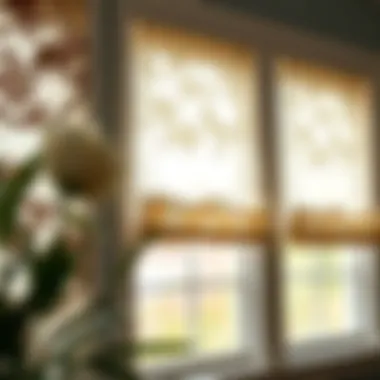
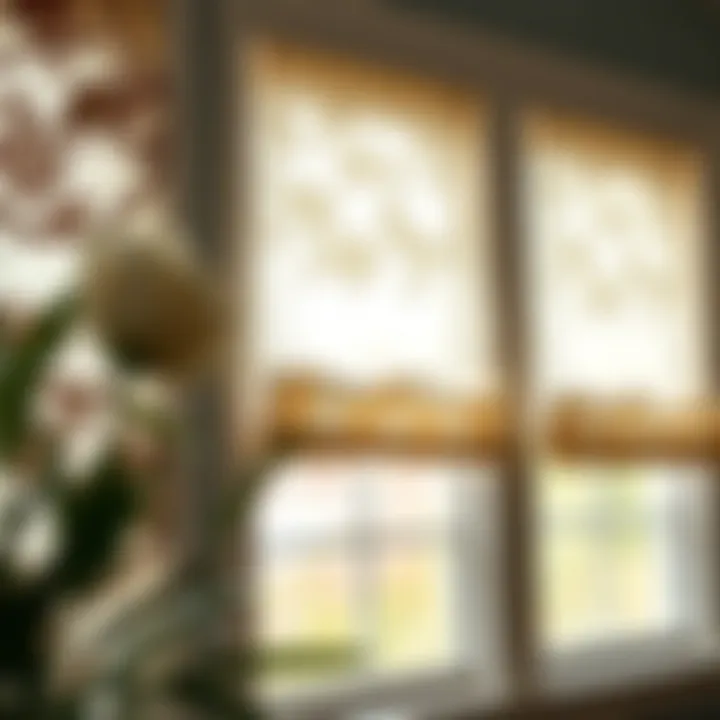
When you think of blinds, the first image that might pop up is that of wooden or vinyl versions. However, paper blinds offer a refreshing twist on this classic treatment. They provide a comparable level of privacy and light control while embodying an eco-friendly appeal. One unique advantage of paper blinds is their cut-to-size functionality. You can easily trim them to fit non-standard window sizes without breaking a sweat.
The let-in light is also adjustable; if you'd like to get slightly more illumination during the afternoon, merely tilt the slats. This kind of versatility adds to the layers of control you have over your home environment. Are you someone who loves the organic textures of nature? Paper blinds often come in various finishes like bamboo, bringing a touch of the outdoors right into your living space.
Origami Window Treatments
For those with an artistic flair or a love for unique decor, origami window treatments provide an unconventional yet stunning option. Designed using intricate folds, these treatments can significantly elevate the aesthetic of any room. Besides their visual appeal, these window coverings can also be highly functional. Depending on the style, they can allow for varied light diffusion or complete blackout.
An appealing aspect of origami window treatments is the opportunity to personalize. Not all origami styles are created equal, and there’s room for imaginative interpretation. You have the freedom to mix not just colors but also patterns, giving a distinct character to your space.
Curtains and Drapes
While curtains and drapes typically evoke thoughts of fabric, paper options are equally captivating. Known for their lightweight nature, paper curtains can be a perfect choice for spaces where heavy drapery might feel overwhelming. They can either be sheer for light filtering or thicker papers designed for block-out functionality.
These coverings offer excellent versatility in their use; one might find them ideal for both casual settings like sunrooms or more formal areas such as dining rooms. With various patterns available—from sweet florals to bold geometric designs—those seeking a complementary look with existing interior themes have a wealth of options at their disposal.
Benefits of Paper Window Coverings
Paper window coverings bring a wealth of advantages that often fly under the radar. They provide not just a practical approach to window treatment but also an array of aesthetic and environmental benefits. In this section, we will explore four primary advantages of these innovative coverings: cost-effectiveness, light control and privacy, design flexibility, and environmental sustainability. Each of these areas speaks to the multifaceted value of paper window coverings, making them a savvy choice for homeowners, renters, designers, and even retailers.
Cost-Effectiveness
When it comes to budgeting for home decor, the costs can rack up quicker than you can say "window treatment." Paper coverings stand out in that aspect. They are generally more affordable than fabric, wood, or even vinyl options. This makes them a prime choice for those looking to revamp a space without breaking the bank.
- Affordable Options: Getting quality window covers doesn’t have to drain your wallet. Simple roller shades or paper blinds can provide chic styles at a fraction of the price of their counterparts.
- DIY Potential: Many enthusiasts take the matter into their own hands. Crafting your own origami window treatments or custom paper shades can be as simple as a weekend project. Not only is it cost-effective, but it’s also an iron-clad way to ensure each piece is unique.
"Cost shouldn’t be a barrier to achieving style in your home; paper window coverings offer solutions that make good sense for your wallet."
Light Control and Privacy
With paper window coverings, light control becomes an art form. Imagine the ability to effortlessly regulate how natural light floods your room, all while ensuring your privacy.
- Versatile Light Modulation: From sheer options that allow diffused daylight to solid types that block harsh rays completely, there’s a spectrum to satisfy every need. This adaptability can transform the feel of a room, from bright and airy to cozy and intimate.
- Privacy Shield: Homeowners often seek the tranquil balance between visibility and privacy. Paper blinds can be fully drawn down or partially opened to provide light while still safeguarding your sanctuary from prying eyes. In urban settings or close-proximity living, this aspect cannot be overstated.
Design Flexibility
One of the outstanding traits of paper window coverings is their design flexibility. They can seamlessly fit into different decor styles, becoming a subtle accent or a bold statement.
- Variety of Styles: Whether you’re into minimalist Scandinavian designs or bohemian chic, there’s something for everyone. The array of colors and patterns can complement existing decor or set the stage for new themes.
- Custom Solutions: If off-the-shelf designs aren't doing it for you, consider bespoke paper treatments. The possibilities are nearly endless. From hand-painted designs to patterned prints, you can create something that speaks to your esthetic.
Environmental Sustainability
At a time when eco-conscious choices are increasingly important, paper window coverings come out on top as a sustainable option. Made mostly from renewable resources like bamboo and recycled paper, these treatments leave a smaller footprint on our planet.
- Biodegradable Materials: Unlike synthetic materials that take years, maybe centuries, to break down, paper products are biodegradable. When the time comes for replacement, you can dispose of them in an eco-friendly manner.
- Low Energy Production: The manufacturing process of paper coverings generally consumes less energy compared to options like plastic or metal treatments, making them a greener choice overall.
As we dive deeper into the world of paper window coverings, it becomes apparent that they’re not just a fad; they bring together affordability, functionality, aesthetic appeal, and sustainability. This blend of benefits paves the way for their growing popularity among diverse consumers.
Aesthetic Considerations
When choosing window coverings, the visual impact they create can influence a room's ambiance. Paper window coverings offer diverse aesthetic possibilities, making them a practical choice for homeowners, designers, and DIY enthusiasts alike. Understanding the aesthetics of paper window coverings goes beyond mere decoration; it affects how they complement the overall decor and atmosphere of a space.
Color and Pattern Selection
Picking the right color and pattern is critical in the context of paper window coverings. With an almost dizzying range of options available, one might feel like a kid in a candy store. Bright hues can inject energy into a room, while soft pastels tend to create a more serene environment. It's essential to consider how these choices align with the overall color scheme in the home.
When selecting colors:
- Consider Room Functionality: A lively living room might benefit from bold shades, whereas a tranquil bedroom could use softer, muted tones.
- Assess Natural Light: Bright colors can appear more vibrant in well-lit spaces, while darker shades might absorb light and create a cozier feel.
- Personal Style: Choosing patterns like florals or geometric designs can express individuality. Just be mindful—too many busy patterns can lead to visual chaos if not balanced well.
Moreover, many paper window coverings come adorned with textures or prints—from delicate lace effects to striking abstract designs. These elements can add layers of depth to your decor, accentuating other design features in a room.
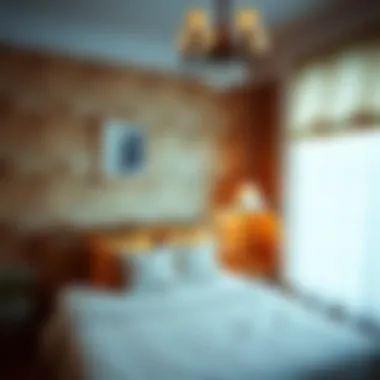

Cohesion with Interior Design Themes
Matching your window treatment with the room’s interior design theme is crucial for achieving a harmonious look. Window coverings can act as a bridge between various design elements, creating a cohesive feel throughout the space. This integration can elevate the overall aesthetic, transforming a room from ordinary to outstanding.
For instance, in a minimalist setting where the philosophy leans towards simplicity and function, sleek paper roller shades in neutral colors can blend effortlessly with the decor. On the other hand, a bohemian-inspired area may welcome vibrant, patterned paper blinds that reflect its laid-back vibe.
Considerations for Cohesion:
- Style Reflection: Ensure that the style of the window covering aligns with the furniture and decor in the room. For example, vintage-inspired designs may clash in modern settings.
- Color Harmony: Looking for colors that echo the shades found in other decor elements, such as cushions or artwork, can create a unified look.
- Material Mix: While paper is versatile, mixing materials can add visual interest. For example, combining paper shades with wood furniture can create a warm, inviting space.
"Your home reflects your style. Choose wisely and let your window coverings speak volumes about your aesthetic preferences."
In summary, the aesthetic considerations surrounding paper window coverings are multi-faceted. Thoughtful color selections and cohesive design choices can dramatically enhance a room's atmosphere, appealing to both the homeowner’s taste and the functional demands of the space.
Installation and Maintenance
Installation and maintenance are vital components in the life of paper window coverings. Getting these aspects right ensures that the beauty and functionality of the treatments are preserved. Homeowners, renters, designers, and DIY enthusiasts alike can benefit greatly from understanding the proper methods of installing and caring for these versatile window solutions.
Installation Tips
When it comes to installing paper window coverings, a few straightforward strategies can make a world of difference. The first step is to determine the right measurements. Always measure twice, as they say. This minimizes the chance of errors that could lead to ill-fitting coverings.
- Choosing the Right Space: Before you begin, consider the space where the coverings will be hung. Some rooms may experience more sunlight than others, so lighter shades can be utilized in those areas to diffuse the harsh light.
- Tools Needed: A simple toolkit typically includes a tape measure, a level, and an adhesive for those types that may not come with their own. Having these tools on hand makes the process much smoother.
- Follow Manufacturer Guidelines: Always refer to the instructions provided by the manufacturer. Each product can have specific requirements that are unique to its construction and design.
A crucial tip is to look out for ways to incorporate additional features like pulleys or brackets, especially for roller shades. This can improve usability and aesthetic appeal, allowing the user to easily adjust the shades with a gentle pull.
Care and Cleaning
Taking proper care of paper window coverings is essential to ensure their longevity and aesthetic appeal. Paper may not be as sturdy as its fabric or vinyl counterparts, yet it can still hold its ground when cared for correctly.
- Regular Dusting: Use a soft cloth or a feather duster to remove dust and debris. This simple act can help maintain the vibrancy of printed designs and prevent dirt build-up, which can be a headache down the line.
- Spot Cleaning: For stains, always use a clean barely damp cloth and gently blot the area. Avoid soaking the paper, as excess moisture can lead to warping or tearing. A spray bottle filled with water can be handy for lightly misting without oversaturating.
- Storage Tips: If you ever need to take them down, storing them flat is best. Avoid rolling them as this can lead to creases and unsightly marks.
"Proper maintenance not only keeps your coverings looking great, but it also enhances their overall performance."
In summary, installation and maintenance of paper window coverings deserve attention. With the right tips and care methods, the vibrant appeal and functionality of these window treatments can last for years, making them a worthwhile investment in any space.
Innovations in Paper Window Coverings
The world of window treatments has always been a canvas for creativity and practicality, yet in recent years, the focus has shifted significantly toward innovation, especially with paper coverings. This section sheds light on how advancements in technology and materials are propelling paper window coverings into a new era, making them not just functional but also a staple in modern design.
Technological Advances
Paper window coverings have witnessed a plethora of technological enhancements that elevate them beyond mere sheets of paper. One of the most notable developments is the integration of smart technology. Imagine a light-filtering roller shade that can be controlled via a smartphone app or voice activation. These innovations have proven to be game-changers for many homeowners looking to merge convenience with sophistication.
Another remarkable advancement is the introduction of high-performance coatings. These coatings give paper coverings enhanced durability and resistance to moisture, making them suitable for various environments, including kitchens and bathrooms. As they become more resilient, the lifespan of paper window coverings is extended, providing lasting benefit without the need for frequent replacements.
Furthermore, advancements in printing technology have made it possible to incorporate intricate designs and vibrant colors directly onto the paper. Digital printing techniques now allow for customization at a level that was previously unattainable. Designers and homeowners can choose everything from subtle textures to extravagant artwork, ensuring that every window treatment reflects personal style.
Trends in Eco-Friendly Materials
With the increasing awareness about environmental issues, there’s been a pressing demand for sustainable materials in all product categories, including window coverings. The paper used for these treatments is undergoing a transformation, becoming more eco-friendly than ever.
A prominent trend is utilizing recycled materials. Manufacturers are increasingly sourcing post-consumer recycled paper, significantly reducing waste and the carbon footprint associated with production. Such paper maintains quality while supporting sustainability initiatives, something discerning consumers are keen to back.
Moreover, many brands now boast certifications, ensuring that their paper is sourced sustainably and produced with non-toxic chemicals. This aligns perfectly with the devices that aim to create healthier living spaces. Consumers are more mindful of indoor air quality, and they are more than willing to opt for window coverings that reflect their values.
In addition, there’s a growing market for biodegradable papers. Unlike traditional papers that may take centuries to decompose, biodegradable options break down naturally, contributing to a healthier planet.
“By choosing eco-friendly materials, we ensure that our choices support the environment while still fulfilling our aesthetic needs.”
Overall, the fusion of technology and sustainability within the realm of paper window coverings marks a significant evolution in the industry. It's a time where design meets responsibility, and that intersection creates both beauty and peace of mind for consumers.
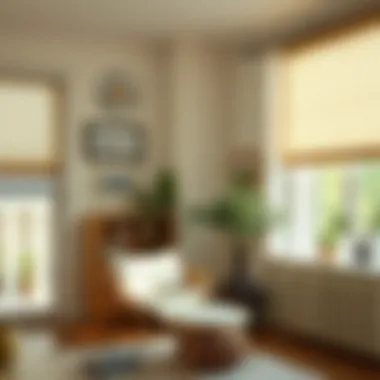
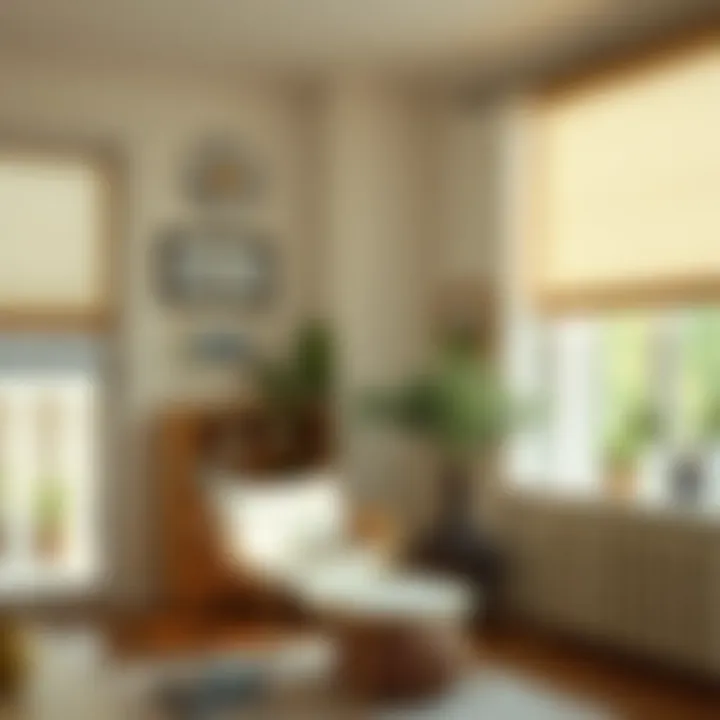
Comparative Analysis with Other Window Treatments
In this section, we will dive into the world of paper window coverings by examining them alongside other popular window treatment choices. This comparative analysis sheds light on the strengths and weaknesses of paper window coverings relative to fabrics, vinyl, and wood options. As we discuss each pairing, homeowners, renters, and designers can gain valuable insights when considering their own window treatment journeys.
Paper vs. Fabric Window Coverings
When it comes to window coverings, fabric options have long been favored for their elegance and warmth. Kicking it off, fabric provides a vast array of colors and textures that can instantly enhance a room. Plus, they have the benefit of being more durable in some cases. Yet here’s where paper shows its cards:
- Affordability: Paper coverings often cost far less than premium fabrics. For those trying to stick to a budget, this is a no-brainer.
- Eco-Friendly Options: Many paper treatments are made from recycled or sustainable materials, whereas fabric might not always be sourced ethically.
- Light Control: Paper shades can offer sharp, clean lines and a minimalist aesthetic that fabric can't always achieve.
However, fabric does have its perks. It can provide more comprehensive insulation against temperature fluctuations. A cozy woolen drapery may give a snug feel during winter months that a paper covering simply can't duplicate.
"When it comes to balancing aesthetic appeal with functionality, knowing how paper fares against fabric can save homeowners both money and headaches in the long run."
Paper vs. Vinyl and Wood Options
As modern window treatment solutions evolved, vinyl and wood coverings have carved a niche for themselves between budget and high-end markets. Paper window coverings hold their own in this matchup too.
- Cost-Effectiveness: Paper window treatments are often lighter on the wallet compared to wooden or vinyl choices. This makes them a savvy option for renters or anyone who enjoys changing up their decor frequently.
- Weight and Installation: Paper is lighter, which often allows for easier installation. In contrast, vinyl and wood can be bulky and may require more physical effort to mount properly.
- Environmental Footprint: While wood boasts a natural look that many admire, its production can lead to deforestation concerns. Vinyl, an oil-based product, raises red flags for those pursuing environmentally friendly decor. Here, paper, particularly those sourced from responsible manufacturers, can make a difference.
Nevertheless, wood does add a layer of sophistication, lending spaces a touch of warmth and depth. Vinyl might win points for its durability and resistance to moisture, making it ideal for areas like kitchens and bathrooms where humidity becomes a factor.
To sum it up, when choosing window treatments, weighing the benefits of paper against fabric or more rigid options like wood and vinyl is crucial. Homeowners should consider factors such as budget, aesthetic choices, environmental impact, and how often they wish to refresh their decor. By examining these elements, decisions can become clearer, leading to a harmonious balance between function and style.
Consumer Perspectives
When one delves into the world of paper window coverings, it's essential to tap into the voice of the consumer. Understanding consumer perspectives opens a window into how these products are received and utilized in real life. For homeowners, renters, designers, and even DIY enthusiasts, the feedback and experiences related to paper window treatments form a crucial part of the narrative. This section sheds light on two important subsections: User Experiences and Feedback and Market Trends and Popularity.
User Experiences and Feedback
User experiences with paper window coverings can paint a vivid picture of their practicality and aesthetic appeal. Customer feedback often highlights the various attributes of these treatments, such as costing and ease of installation. For instance, many users appreciate how affordable paper options are compared to fabric or hardwood blinds, allowing them to refresh their spaces without breaking the bank.
In addition to cost, the design flexibility offered by paper window coverings often garners positive responses. Reviews may reveal how homeowners enjoyed experimenting with colors and patterns, which can be adapted to match distinctive interior styles. Users frequently share their experiences on platforms like Reddit or Facebook, where discussions can reveal the attractiveness and charm paper coverings add to a room. Here's what some users often point out:
- Light Coverage: Many find that paper shades provide just the right amount of light, balancing privacy with brightness.
- Eco-Friendly Choices: Feedback often emphasizes the appeal of sustainable materials, as many brands are noted for using recycled or biodegradable processes.
"I wasn't sure about using paper shades, but they turned out perfectly, and my living room feels so cozy! Plus, I love that they’re more eco-conscious than other options."
Such testimonials assist potential buyers in making informed decisions, driving home the significance of consumer experiences when opting for paper window treatments.
Market Trends and Popularity
The popularity and market trends surrounding paper window coverings are telling as well. Industry reports and consumer surveys point to a noteworthy shift toward lightweight, versatile options for window treatments. Recent market trends indicate an increasing turnover in demand for eco-friendly and sustainable products. Given the growing awareness of environmental issues, consumers are gravitating towards materials that offer minimal impact on the planet.
Moreover, as the housing market fluctuates and the DIY movement expands, more individuals are showing interest in customizable and easily installable options, which paper window coverings fit perfectly. Retailers across platforms, be it online marketplaces or local home improvement stores, report a steady rise in both interest and sales of these products. Some trends to keep an eye on include:
- Increased online shopping: The ease of finding a variety of patterns and colors online has accelerated sales, with many first-time buyers eager to explore.
- Popularity of minimalist design: Many folks now prefer the clean lines and natural feel of paper, as it aligns with contemporary tastes.
- Buzz around multifunctionality: Consumers are intrigued by the idea of window treatments that not only serve aesthetic purposes but also contribute to energy efficiency.
From these perspectives, it’s clear that understanding consumer experiences coupled with market trends provides valuable insights into how paper window coverings are enhancing homes and adapting to the needs of today's environmentally conscious and style-savvy clientele.
Epilogue and Future Directions
The exploration of paper window coverings not only highlights the practical aspects of these versatile designs but also opens the door to potential innovations within the industry. With a growing emphasis on sustainability and aesthetics, the future of paper window coverings appears promising. Homeowners, designers, and retailers would benefit from recognizing the unique attributes that these products can bring to various spaces.
Summation of Key Points
In this article, we covered a broad range of topics related to paper window coverings:
- Types and Styles: From roller shades to origami treatments, we delved into how each type contributes uniquely to any interior ambiance.
- Benefits: We established that cost-effectiveness, light control, and environmental sustainability are significant advantages of using paper window coverings, making them attractive choices for a diverse audience.
- Aesthetic Compatibility: Strong focus was placed on selecting colors and patterns that not only enhance the space but also resonate with the overall interior design theme.
- Installation and Maintenance: We shared practical tips on installation procedures and maintenance, emphasizing their simplicity and low-cost care.
- Consumer Feedback: We analyzed user experiences reflecting on the growing popularity of these eco-friendly options in the market.
These points together articulate a comprehensive understanding of why paper window coverings are not just a fleeting trend but a viable alternative in contemporary design.
Potential Developments in the Industry
As we look to the future, certain trends signal where the industry might be headed:
- Technological Innovations: Manufacturers may start integrating smart elements into paper window coverings, offering users not only efficiency but also enhanced controls.
- Eco-Friendly Materials: The emphasis on sustainability is shifting product development. Expect advances in biodegradable and recyclable materials that maintain the functionality of paper without compromising ecological integrity.
- Customization Options: As consumer tastes become more personalized, the demand for unique designs and custom solutions will likely increase. Companies may innovate by offering users a chance to personalize their paper window treatments significantly.
- Cross-Industry Collaborations: Partnerships between designers and manufacturers can lead to one-of-a-kind releases that blend art and function, creating showpiece window coverings that narrate a story visually.

